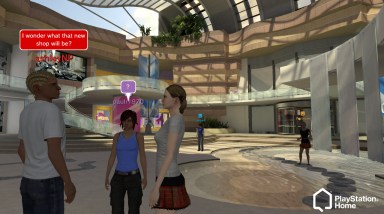
About 18 months in the making, Home is Sony’s “Hail Mary” play in the console battle with Nintendo and Microsoft. It will test whether gamers really want a layer of social networking served on top of the games they play on the PlayStation 3 game console. By contrast, Microsoft and Nintendo believe that gamers might talk to each other via cute little characters. But Sony has built a full-blown virtual online space. The graphics of the characters look good. But they don’t really move their lips or express themselves physically; that’s something that will change over time.
[aditude-amp id="flyingcarpet" targeting='{"env":"staging","page_type":"article","post_id":99814,"post_type":"story","post_chan":"none","tags":null,"ai":false,"category":"none","all_categories":"games,social,","session":"D"}']Susan Panico, senior director of the PlayStation Network at Sony’s U.S. game division in Foster City, Calif., said that Sony isn’t the first to market, but it has a big opportunity with Home because consumers already trust the Sony name. While Home could have been many things, Sony decided to focus the content around playing games and the culture around them, said Jack Buser, director of Home for the U.S. game division.
“It’s really a 3-D social network for gamers,” he said.
AI Weekly
The must-read newsletter for AI and Big Data industry written by Khari Johnson, Kyle Wiggers, and Seth Colaner.
Included with VentureBeat Insider and VentureBeat VIP memberships.
The PlayStation Network — which has 13 million PlayStation 3 and PlayStation Portable registered users — is tightly integrated with Home. The PSN is the network that gamers use to play each other in online matches. They can also use it to download games or videos to the hard drives of their consoles. It has the records of a player’s achievements (trophies) in games, such as the number of victories in an online game.
But Home isn’t really a world. It’s more like a series of virtual spaces. If you want to visit your own personal apartment, where no one can visit without your permission, then you teleport there. If you want to go to the central plaza, you teleport there. Same goes for the bowling alley or the bar from the game Uncharted. You’re free to decorate your home as you wish. If you want to listen to music, you can walk up to a jukebox.
You communicate with other avatars by moving next to them and typing words. It’s not so easy doing that with a game controller. But you can plug a universal serial bus keyboard into a PS 3, and you can also use any Bluetooth head set to talk as well. At some point, you will be able to walk up to a group of friends and spawn a multiplayer game.
[aditude-amp id="medium1" targeting='{"env":"staging","page_type":"article","post_id":99814,"post_type":"story","post_chan":"none","tags":null,"ai":false,"category":"none","all_categories":"games,social,","session":"D"}']
The bowling alley has a number of social games: bowling of course, arcade machines, and pool. The pool game even has accurate physics. The arcade machines are basically emulators of your old favorites. When you click on a machine to play a game, the game itself fills your whole screen.
In the movie theater, you can go into a room and see what’s playing. You can actually watch that movie with your avatar in a social setting, making comments about it that others in the theater can see. That turns movie-watching into an online social experience. The closed beta is restricted to those 18 years and older now, while the open beta will allow anyone 13 and older. There is a profanity filter, and Home will be compliant with the PS 3’s own parental controls.
The version the Sony folks showed me was still incomplete. Sony hasn’t mentioned a release date yet, but Panico says an open beta will start soon. There aren’t many people around in it now. I imagine it will be fun once there are millions of people, all creatively expressing themselves through wacky avatars. But I expect it will be rather lonely and boring at the outset. It will also grow more interesting when partners like Electronic Arts start building out features such as an EA Sports fan space. Publishers, brand owners and media companies are all creating their own spaces inside Home, Buser said.
He said that Home will constantly change, with some things disappearing if they become less popular, and new spaces appearing as they are built. He said Sony will listen carefully to community feedback as it expands the service.
[aditude-amp id="medium2" targeting='{"env":"staging","page_type":"article","post_id":99814,"post_type":"story","post_chan":"none","tags":null,"ai":false,"category":"none","all_categories":"games,social,","session":"D"}']
“Home is a living, breathing space,” he said.
VentureBeat's mission is to be a digital town square for technical decision-makers to gain knowledge about transformative enterprise technology and transact. Learn More
